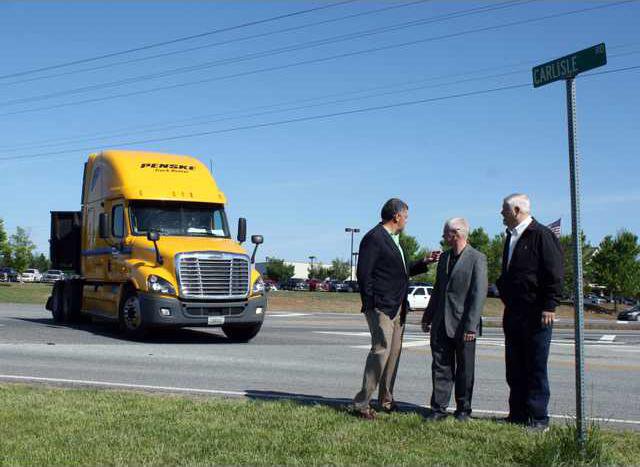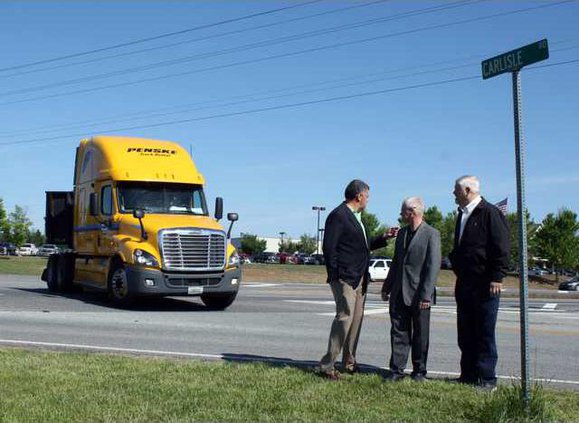The state's top transportation official was on a tour of several roads in Dawson County Friday as crews on Ga. 400 continued work to improve the intersection of Hwy. 53.
DOT Commissioner Russell McMurry said utility lines are being moved in the current construction phase of what will be the state's first continuous flow intersection (CFI), a plan designed to move traffic with displaced left hand lanes on Ga. 400.
"Most people forget about the utilities that have to be moved for road construction. It takes a lot of work to get those moved," he said. "We're working through private partnerships and water authorities. It takes a lot of agreements and arrangements with contractors.
"They have to coordinate all their schedules. Power has to move first to a new power pole and then telephone and then cable has to move. They can't do it all at one time."
Similar in principle to diverging diamond interchanges like those now in place at some busy Interstate 85 and 285 interchanges, the project moves left-turning vehicles out of traffic's main flow by using a series of access roads and longer left-turn lanes.
McMurry, who has held his position since January, called the changes the most economic, efficient and safest option for the crossing.
"This intersection makes it much more safe because you don't have people trying to make left turns at the intersection and they don't have to cross in front of each other," he said. "The left turns are now down instead of in the middle of 400, they're done on the outside edge of 400, where there's no other traffic coming at them. That's a huge benefit."
The $14 million construction project is expected to take 18 months to complete and would be staged so as not to disrupt traffic.
The original plan called for an interchange up and over Ga. 400 that would have cost an estimated $150 million.
"You'd have had these big walls and you wouldn't be able to see one side of the road from the other. So if you were headed north, you couldn't see the outlet mall or the McDonalds in the corner," he said. "We started working way back then to try to come up with a different solution."
The CFI concept, according to McMurry, is the "right balance for safety, commerce and mobility."
"We all know how important this area is for the county, for the region. [Ga.] 400 is still a major artery from Lumpkin County into Atlanta," he said.
Ga. 400 in Dawsonville is also a major revenue generator for Dawson County.
Plans are also in place for two new retail centers at its intersection with Dawson Forest Road, though the big box stores are not ready to officially announce openings.
"They're really waiting on the road structure. They've got to make sure they've got the ingress and egress that they need to bring shoppers here," said County Commission Chairman Mike Berg. "There's $100 million worth of construction, 500 jobs. Some folks are already committed to build and have signed agreements. It's just a matter of putting everything together."
According to Sen. Steve Gooch, R-Dahlonega, much of the economic development potential hinges on having "good ingress and egress on our public roads."
"Without that, they won't come," he said.
The General Assembly passed a bill earlier this month that allocates an additional $1 billion annually to the state's transportation needs.
"That's going to give the DOT an extra billion dollars a year to work on some of these good projects," Gooch said. "Now we're going to be able to get some of that money out to put it to work, so I wanted to get the commissioner up here early before the new fiscal year starts and look at what Dawson County's needs are and other counties in my district and see where we can spend out allocation of that money."
Gooch said there are several needed road projects in Dawson County that have been overlooked for too long.
"There are some issues here in Dawson County that have been put on the back burner for years, because funding wasn't there, and I think now is a good time to readdress them," he said. "Traffic lights out here on 400, maybe a round-about at Dawson Forest and Hwy. 9 South, and some areas where there is some economic development possibilities."
DOT has in "about the last year and a half," according to Berg, "put a lot of emphasis" in Dawson County, with plans to replace the bridges over the Etowah Rover on Hwys. 136 and 9 South.
"There's also the three new round-abouts, several smaller projects and of course, then the CFI, that's a $14 million project," he said.
"People who drive through here are going to experience some delays and some changes, but in the end, what you get out of it is quicker moving traffic, an easier way to get east and west, which is very important to us."

